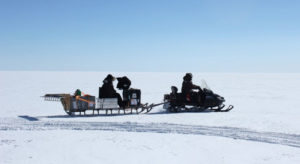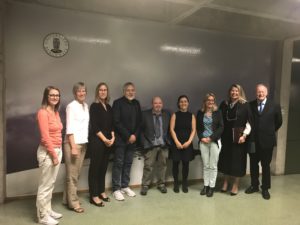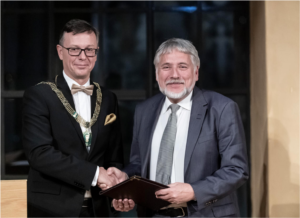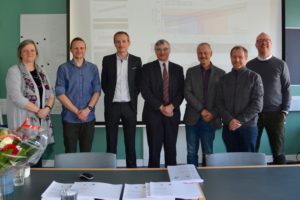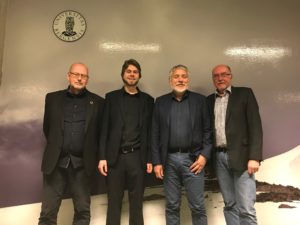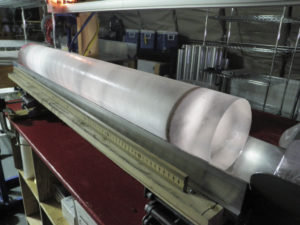New, detailed study of the Renland Ice Cap offers the possibility of modelling other smaller ice caps and glaciers with significantly greater accuracy than hitherto. The study combined airborne radar data to determine the thickness of the ice cap with on-site measurements of the thickness of the ice cap and satellite data. Researchers from the Niels Bohr Institute – University of Copenhagen gathered the data from the ice cap in 2015, and this work has now come to fruition in the form of more exact predictions of local climate conditions.
Author: jorunds
Nora Loose successfully defended her thesis today!
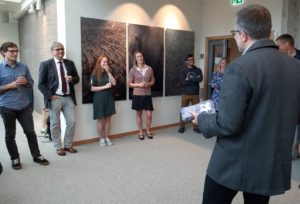 Supervisor Kerim Niscancioglu giving a speech at the celebration of Dr. Nora Loose.
Supervisor Kerim Niscancioglu giving a speech at the celebration of Dr. Nora Loose.
The 30th of August Ice2ice PhD Nora Loose successfully defended her PhD on “Adjoint Modeling and Observing System Design in the Subpolar North Atlantic”.
Yet another Ice2ice PhD defended her thesis today! We want to congratulate Dr. Loose with her important contributions to the understanding of the climate system in the Subpolar North Atlantic.
If you want to read more about her work, here is a summary of her work published on the Bjerknes webpage today.
Evangeline Sessford successfully defended her thesis!
Last Friday Evangeline Sessford successfully defended his thesis for the PhD degree at the University of Bergen. The thesis is entitled: “Hydrography in the Nordic Seas During Dansgaard-Oeschger Events 8-5”. The assessment committee consisting of Professor, ph.d. Mary Elliot, Paleoclimats Paleoenvironnements Bioindicateurs, LPG Université de Nantes, France, Researcher, ph.d. Jeroen Groeneveld MARUM – Zentrum für Marine Umweltwissenschaften Universität Bremen, Germany and Haflidi Haflidason, Department of Earth Science, University of Bergen.
You can read more about the thesis here, unfortunately only in Norwegian.
Meltzer special award given to Eystein
New Ice2ice “not any more PhD” – Andreas Plach successfully defended his thesis
Andreas Plach successfully defended his thesis at the University of Bergen 5th March. The thesis is entitled “Simulation of the Eemian Greenland ice sheet“.
His supervisors has been Kerim Niscancioglu, Andreas Born (both University of Bergen) and Bo Møllesø Vinther (University of Copenhagen). The assessment committee consisting of Professor, ph.d. Anders Schomacker, Institutt for geovitenskap, Universitetet i Tromsø, Assistant Professor, ph.d. Miren Vizcaino, Department of Geoscience and Remote Sensing (GRS), Delft University of Technology, Nederland and Atle Nesje, Department of Earth Science, University of Bergen.
You can read more about the thesis here, unfortunately only in Norwegian.
Martin Olesen successfully defended his thesis
Martin Olesen successfully defended his thesis at the University of Copenhagen Monday 18th February. The thesis is entitled “High resolution climate simulation. Methods for improving and customising climate information with focus on outreach and uncertainty assessment”. His supervisors has been Jens H. Christensen, Peter Lang Langen and Eigil Kaas. The assessment committee consisting of Aslak Grinsted, Niels Bohr Institute, KU. Prof. Dr. Daniela Jacob, GERICS, Institute Helmholtz-Zentrum Geesthacht and Research Prof. Tim Carter, Finnish Environment Institute.
You Can read the abstract at the Niels Bohr Institute webpage
New Ice2ice PhD thesis “solves mysteries around large abrupt climate changes”
Henrik Sadatzki successfully defended his thesis for the PhD degree at the University of Bergen. The thesis is entitled: “Sea ice variability in the Nordic Seas over Dansgaard–Oeschger climate cycles during the last glacial – A biomarker approach”
The last glacial period (ca. 10,000–100,000 years ago) was marked by repeated abrupt climate changes that had global implications. It is known from ice core records from the Greenland Ice Sheet that these glacial climate fluctuations comprised temperature shifts of up to 15°C over the Greenland ice sheet, happening within years or decades. These are the most prominent abrupt climate changes that we have recorded. While the underlying mechanisms of these so-called Dansgaard–Oeschger climate events are not yet fully understood, it is believed that changes in sea ice cover and ocean circulation in the Nordic Seas have played a key role in driving these enigmatic events.
In his studies, Sadatzki investigated the nature, timing and role of changes in sea ice cover in the Nordic Seas during several abrupt Dansgaard–Oeschger climate events ca. 30,000–40,000 years ago. For this purpose, he extracted and analyzed specific organic molecules from marine sediments, which were produced by certain sea ice algae and other phytoplankton thousands of years ago.
Sadatzki´s thesis documents sea-ice changes with an unprecedented detail, and show that in cold phases the sea ice cover was much more extended than today. The sea ice cover abruptly disappeared over large regions just prior to the abrupt warmings over Greenland. Abrupt changes in the sea ice cover thus have been important for creating the subsequent atmospheric changes.
The results support theories that have suggested that the sea ice cover changes were critical for the abrupt changes. Sadatzki´s work provides unprecedented proxy evidence of expansion and retreat of sea ice in the glacial Nordic Seas, contributing to an improved understanding of the role of sea ice changes in abrupt climate change in the past, and with relevance for the ongoing sea ice reduction in the Arctic today. The results are about to be published in leading international journals.
Eystein Jansen receives the Brøgger prize!
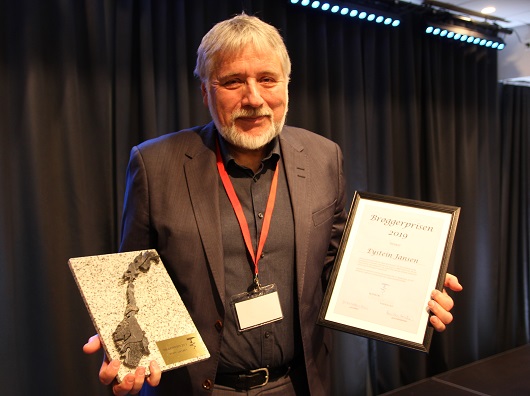
During the annual Norwegian Geological Society winter conference held in Bergen this week Eystein Jansen was today awarded the Brøgger prize. The prize is the highest mark of honor a geologist can be given in Norway and is awarded to persons “…that have contributed in a unique way to understand especially the geology of Norway or geology in general” as written in the prize statutes.
The list of Eystein’s important scientific contributions given by the jury is very impressive; first the establishment of the Laboratory for geological mass spectronomy in Bergen in 1983, then the establishment and leadership in the Bjerknes Center for Climate Research (CoE) for 13 years starting in year 2000, his involvement in the establishment of the SapienCE – Centre for early human behavior (another CoE) in 2017, his contribution to the IPCC report and not at least his decisive role for the understanding the ocean circulation in the North Atlantic and link to the variation of ice sheets during the ice ages.
The fact that he has brought together geologists and modellers to better understand the climate system (as in Ice2ice) is also mentioned as an important contribution by the jury.
Congratulations Eystein!
You can read about Eystein and the award here, unfortunately only in Norwegian.
Arctic2Antarctica: Ice2ice goes global with a new paper published in Nature
by Joel Pedro
In the climate system, like the ecosystem, everything is connected. Arctic terns migrate each year from their Arctic breeding grounds to the Antarctic coast. Our recent paper in Nature shows that a similar 50,000 km journey is made by abrupt Dansgaard-Oeschger (DO) climate change events.
The specific new result is that each Dansgaard-Oeschger event is accompanied—within a few decades—by a pulse of Antarctic warming and a northward shift in the westerly winds that circle the continent. Similarly, when the DO events abruptly end we see a pulse of Antarctic cooling and the westerlies shift back north.
The speed at which the southern temperature and wind changes occur implies that, like the terns, they make their way to Antarctica through the atmosphere. The rapid atmospheric changes are superimposed on more gradual (and already well-documented) changes in Antarctic temperature that appear around 200 years later and that are attributed to changes in ocean heat transport and mixing.
To stretch the bird analogy, the terns return north after their foray in the Antarctic sea ice, and similarly Antarctica is not the last stop for the DO signal. The next step is to test whether the wind changes are an important component in driving the next DO event, e.g. through their effects on the overturning circulation, air-sea carbon fluxes and sea ice.
Why the southern westerlies shift with the DO events is not yet fully understood, but model studies suggest a plausible chain of events that matches observations (see our ice2ice paper from earlier this year on this topic): abrupt warming in the Arctic means that the thermal equator is displaced north and the SH Hadley cell strengthens; the stronger SH Hadley cell redistributes energy back into the cooler southern hemisphere, in turn strengthening the sub-tropical jet and drawing the westerlies northward. The resulting Antarctic temperature changes are consistent with the observed influence of the Southern Annular Mode on Antarctic climate, suggesting similar atmospheric dynamics may be involved.
In its details, our study examined ice cores from five different locations around Antarctica and synchronized their dating internally using layers of volcanic ash. Changes in the temperature and in the source regions of Antarctic snowfall were then analysed by looking at water isotope ratios. Credit is due to Christo Buizert (OSU) who led the study and to Bradley Markle, who published similar findings in 2017 that were restricted to the Pacific sector of Antarctica.
What’s wrong with the bipolar ocean seesaw hypothesis?

The thermal bipolar ocean seesaw hypothesis was proposed by Stocker and Johnsen (2003) as the ‘simplest possible thermodynamic model’ to explain the time relationship between Dansgaard-Oeschger (DO) and Antarctic Isotope Maxima (AIM) events. Following the Bergen ice2ice MIS3/Southern Ocean and Bipolar Seesaw Workshop a group of ice2ice researchers and some international collaborators were invited by Quaternary Science Reviews to write a review on the thermal seesaw. The resulting paper, “Beyond the bipolar seesaw: towards a process-understanding of inter-hemispheric coupling” by J. Pedro, M. Jochum, C. Buizert, F. He, S. Barker and S. Rasmussen, is now live and open access at QSR.
In the review we use theory, coupled model simulations and paleoclimate data to test the thermal seesaw. Our results lead to four main challenges to the hypothesis:
- Compensating heat transports: Changes in Atlantic heat transport invoked by the thermal seesaw are compensated by opposing changes in heat transport by the global atmosphere and the Pacific ocean. This compensation (which would come as no surprise to Vilhelm Bjerknes) has a decisive influence on the spatial pattern of climate anomalies. Changed ocean heat transport strongly affects sea ice, triggering ice-albedo feedbacks that dominate the high-latitude climate response. Changed atmospheric heat transport alters the position and intensity of the Hadley circulation and of atmospheric jets and eddies, dominating the response at low to mid-latitudes.
- A global ocean—not Southern Ocean—heat reservoir: According to the thermal seesaw hypothesis, the Southern Ocean acts as a heat reservoir during the DO/AIM events, integrating changes in South Atlantic temperature. We dispute this because South Atlantic temperature anomalies spread much more efficiently into the Indian and Pacific Ocean, by Kelvin and Rossby wave processes and by advection, than they do into the Southern Ocean. This is because the Southern Ocean has no zonal boundary to support waves and because the Antarctic Circumpolar Current (ACC) prohibits advection, since by definition the flow is along the current’s axis. In coupled model simulations the heat content of the Southern Ocean shows very little change during the DO/AIM events; instead, the global ocean north of the ACC better fits the description of heat reservoir.
- Wind-driven thermocline deepening: In the conventional thermal seesaw, a collapse of the AMOC causes heat that would otherwise be advected north to accumulate in the South Atlantic. In our coupled model experiments, a southward shift of the ITCZ accompanies northern high latitude cooling (as commonly seen in previous studies). The ITCZ shift and associated changes in wind stress over the South Atlantic gyre deepen the thermocline there, such that abrupt South Atlantic warming results from reduced northward advection coupled to the wind-driven deepening of the thermocline. The thermocline deepening is essential in enabling heat to be stored at depth rather than released to the atmosphere through the Ekman layer.
- Atmospheric heat transport warms Antarctica: Antarctica warms during AIM events due to an increase in poleward atmospheric heat and moisture transport following sea ice retreat and surface warming over the Southern Ocean. The sea-ice retreat is itself driven by gradual eddy-heat fluxes across the ACC that initiate sea ice melt and are amplified by sea-ice albedo feedbacks. The centennial lag of Antarctic warming after AMOC collapse (WAIS Divide Project Members, 2015) reflects the time required for heat to accumulate in the global ocean interior before it can be mixed across the ACC by eddies and trigger the sea-ice feedback. For the nitty gritty, including our full assessment of the Antarctic and Southern Ocean energy balance during AIM events, please do refer to the paper.
In the spirit of ice2ice the review was a collaboration between ice-core (Buizert, Rasmussen, Pedro), sediment core (Barker) and modelling (Jochum, He) specialists. I’m grateful to all these coauthors for their excellent (and diverse!) inputs and to ice2ice for the support throughout, including for the MIS3/Southern Ocean and Bipolar Seesaw Workshop that kicked this effort off.
Joel Pedro
Hobart, 26 June 2018
References
Stocker, T.F., Johnsen, S.J., 2003. A minimum thermodynamic model for the bipolar seesaw. Paleoceanography 18, 11-1.
Pedro, J. B., Jochum, M., Buizert, C., He, F., Barker, S., Rasmussen S.O., Beyond the bipolar seesaw: Toward a process understanding of inter-hemispheric coupling. Quaternary Science Reviews (in press), https://doi.org/10.1016/j.quascirev.2018.05.005, 2018.
WAIS Divide Project Members, 2015. Precise interpolar phasing of abrupt climate change during the last ice age. Nature 520, 661-665.
